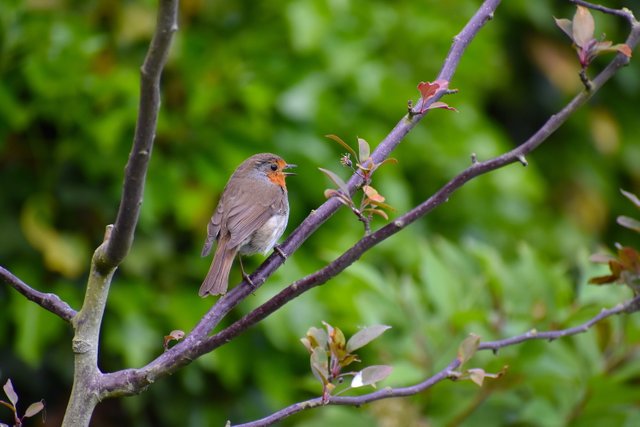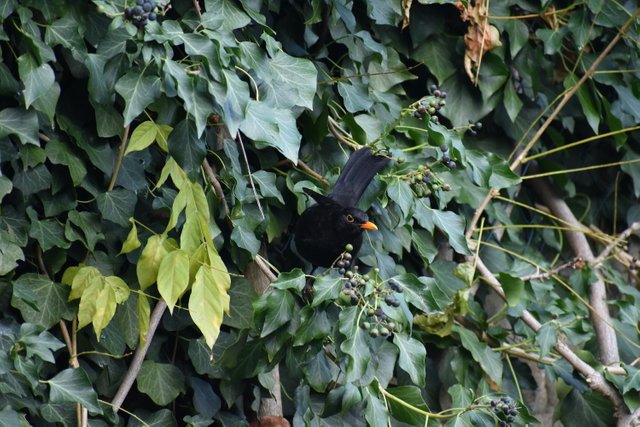Let me introduce you some of my feathered friends which love to hang out in our garden. Hope you enjoy looking at them posing and feeding and maybe you will recognise some before even reading the captions accompanying each photo.
Wooden blue painted garden tools storage shed amongst green grass, potted plants and pink striped deckchairs.
Camera: Nikon D5600 Lens: Nikkor 18-55mm f/3.5-5.6G ISO: 280
Shutter Speed: 1/250 Aperture: f/3.8
A pair of goldfinches eating niger seeds. The European goldfinch (Carduelis carduelis) is a small passerine bird in the finch family. It is highly coloured with a bright red face and a yellow wing patch.
Camera: Nikon D5600 Lens: Nikkor 70-300mm f/4.5-6.3G ISO: 400
Shutter Speed: 1/400 Aperture: f/5.3
The coal tit is a little woodland bird which has a glossy black cap and bib. Its cheeks are whitish and the upperparts are grey-brown.
Camera: Nikon D5600 Lens: Nikkor 70-300mm f/4.5-6.3G ISO: 720
Shutter Speed: 1/250 Aperture: f/5.1
A perched robin singing. The orange red breast endears it to us and male birds use it to settle territorial disputes, especially during the breeding season.
Camera: Nikon D5600 Lens: Nikkor 70-300mm f/4.5-6.3G ISO: 720
Shutter Speed: 1/250 Aperture: f/5.3
The great tit (larger than the blue tit) has white cheeks that contrast its black head and throat and a yellow breast. It is a common sight in woodlands and a frequent garden visitor.
Camera: Nikon D5600 Lens: Nikkor 70-300mm f/4.5-6.3G ISO: 800
Shutter Speed: 1/250 Aperture: f/5.3
The blue tit has a greenish back, navy wings and cap with yellow underparts. The mostly white head is demarcated by a cobalt blue collar which connects to the dark eye stripe and bib. Its bill is short, stubby and the legs are blueish.
Camera: Nikon D5600 Lens: Nikkor 70-300mm f/4.5-6.3G ISO: 1,100
Shutter Speed: 1/125 Aperture: f/5.3
A male blackbird just about to strip an evergreen ivy of its berries and gobble them whole.
Camera: Nikon D5600 Lens: Nikkor 70-300mm f/4.5-6.3G ISO: 1,000
Shutter Speed: 1/125 Aperture: f/5.3
It doesn't take much to make your outdoor space bird friendly by tying a feeder to a tree, a shrub or even installing a feeding station. Don't forget to put up a bird bath too. The delicate garden birds will definitely appreciate your efforts (it helps if you don't have a cat). It won't take them long to become regular visitors and even invite more of their feathered friends to your front or back yard.
A wild bird feeding station with hanging nut, seed and fat ball feeders, a high energy suet block, a water dish and a meal worm tray.
Camera: Nikon D5600 Lens: Nikkor 18-55mm f/3.5-5.6G ISO: 100
Shutter Speed: 1/160 Aperture: f/5
You can also decide to put up a bird box which, when positioned high enough and enabling the birds to free fly straight into it, will sooner or later become occupied by nesting birds.
Wooden bird house with sloped roof and an entrance hole on a tree. Nest boxes are crucial to the survival of the garden birds, providing them a place to rest and raise their young.
Camera: Nikon D5600 Lens: Nikkor 18-55mm f/3.5-5.6G ISO: 2,500
Shutter Speed: 1/60 Aperture: f/3.6

Many colourful nest boxes on a tree in London.
Camera: Nikon D5600 Lens: Nikkor 70-300mm f/4.5-6.3G ISO: 200
Shutter Speed: 1/320 Aperture: f/4.3
Day 7 of 14 Days Diving by @bambuka.
This has been posted as a "50/50" but I commit myself to transfer SBD to SP to Power Up 100% based on the program's rules.








